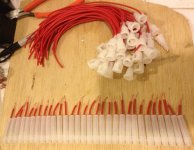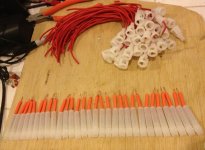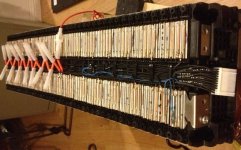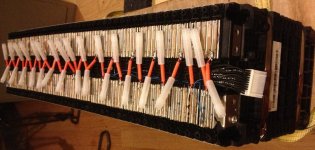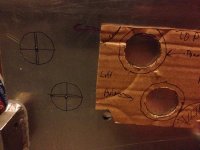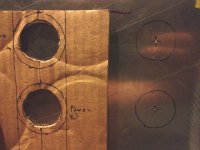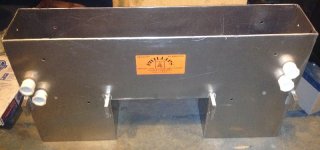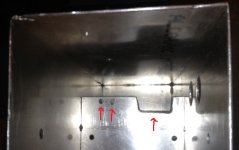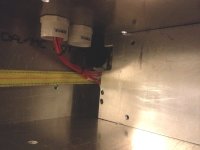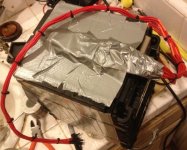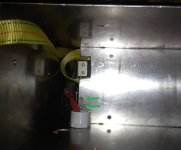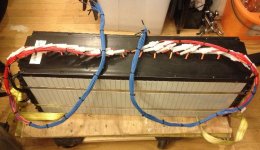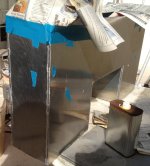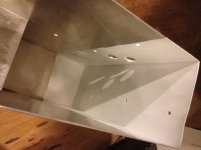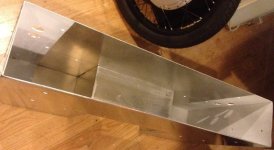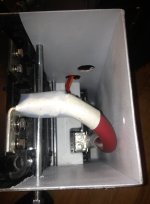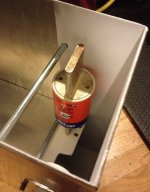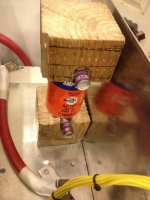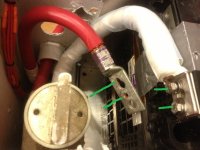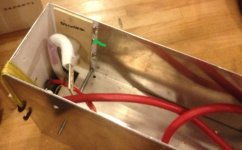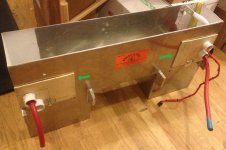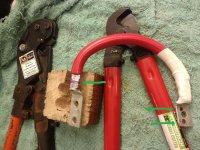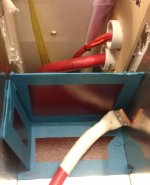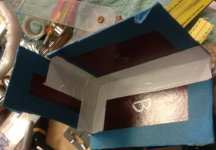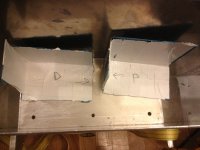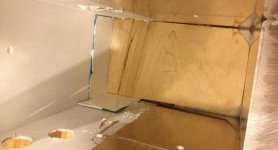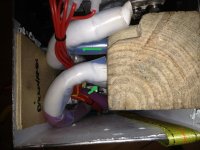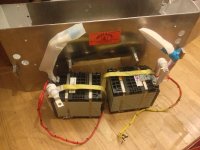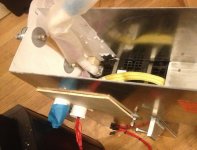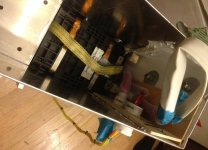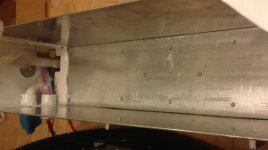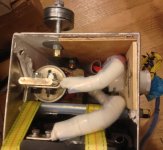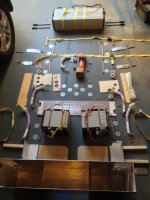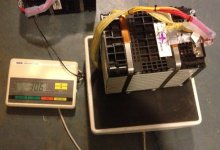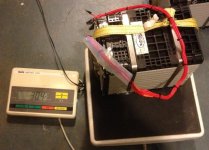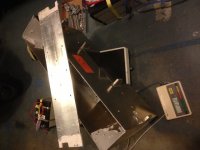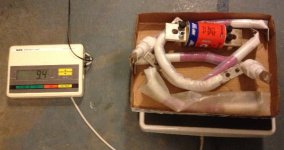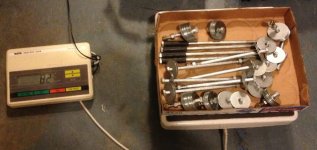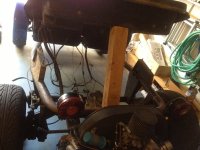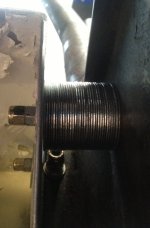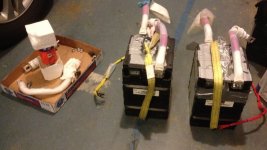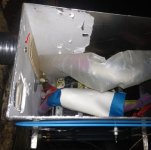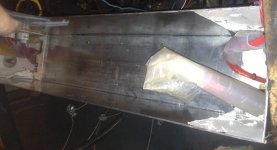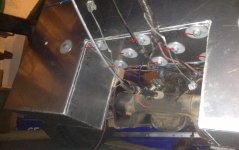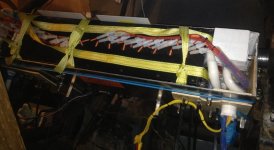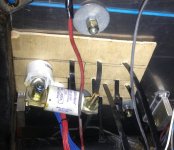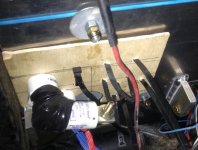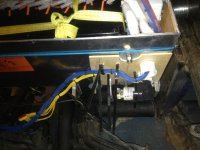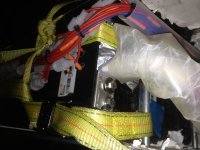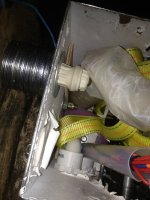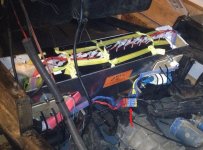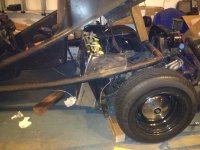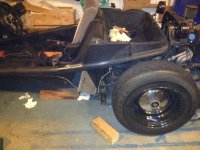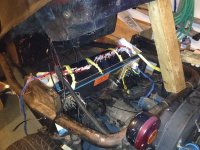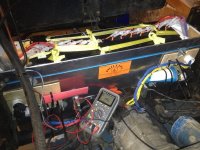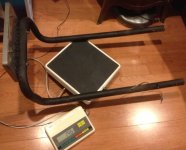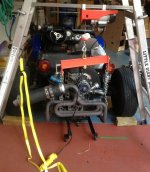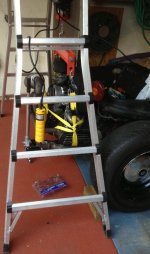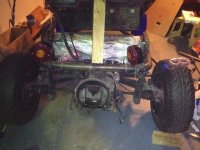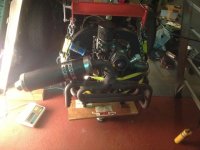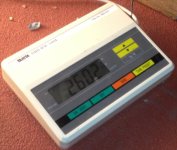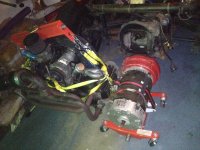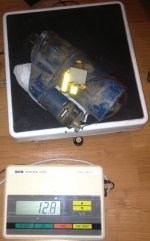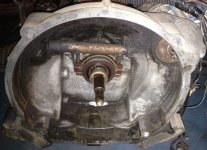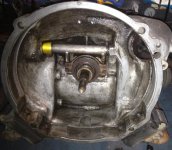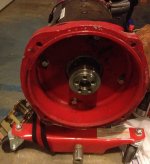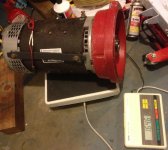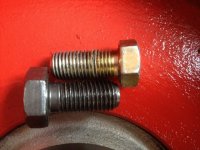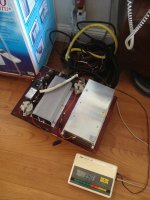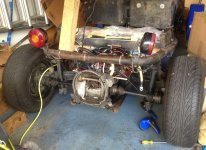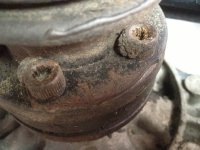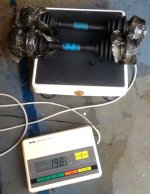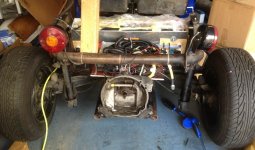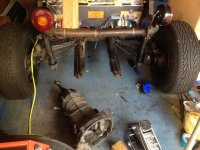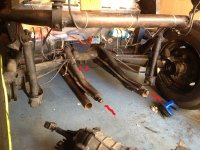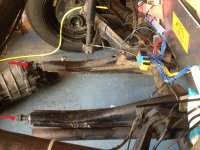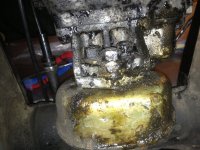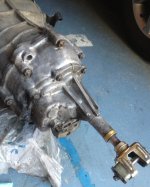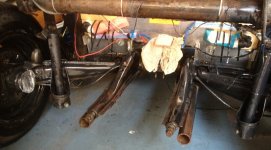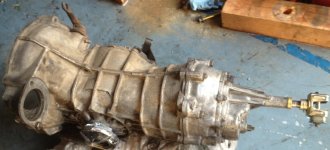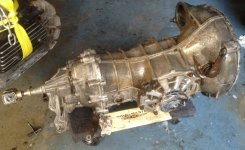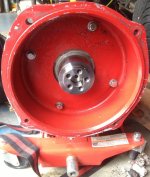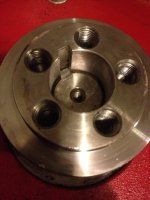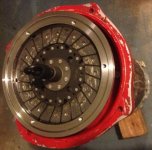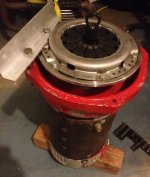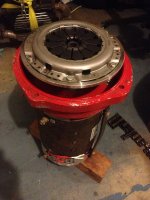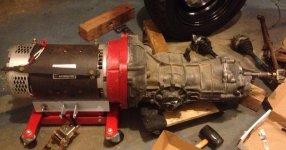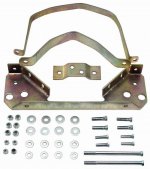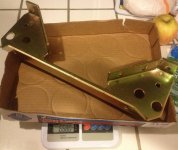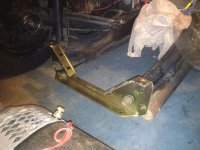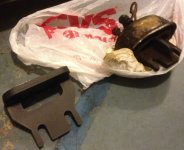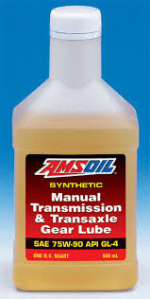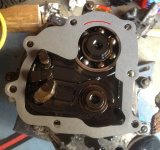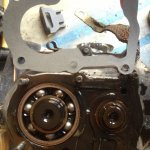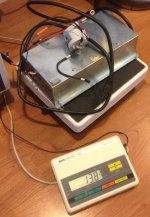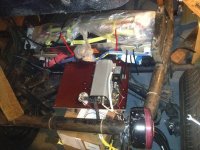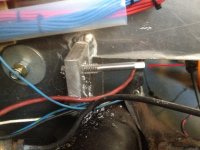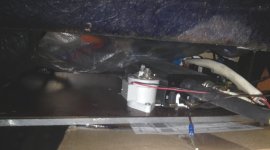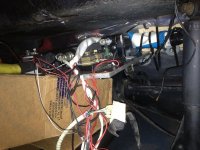Thanks for the tip, Punx0r!

Here is the step-by-step instruction manual I wrote for assembling this battery pack. Sorry that it is pretty dry reading and hence not very interesting, but I wanted to have a copy of it in this build log as a contingency.
Cable Path/module definitions
===========
external 400a fuse
4/0 cable
(ModA) = Module A (7s3p on Passenger's Side) - Negative Power takeoff
=> 500a500v Time Delay Fuse between ModA(+) and ModB(-)
(ModB) = Module B (28s3p on top)
(ModC) = Module C (7s3p on Driver's Side) - Positive power takeoff
external 400a fuse
BATTERY BOX ASSEMBLY SEQUENCE
================================
o MAKE SURE U-BOLTS ARE IN PLACE FIRST
o Work case into place between torsion bar supports
o Install driver outer flange bolt
!! need full thread?
!! no room for inner washer
!! bolt clearance is tight
2.00"-hot dip galvnzd,grade8, 3/8"-16,(2+6) 2"flange washer,nut nylock
- Lube with Big Moose's anti-corrosion gel
o Install passenger outer flange bolt.
!! need full thread?
!! no room for inner washer
!! bolt clearance is tight
2.00"-hot dip galvnzd,grade8, 3/8"-16,(2+6) 2"flange washer,nut nylock
- Lube with Big Moose's anti-corrosion gel
o install driver lower case bolt
1.50"-hot dip galvnzd,grade8, 3/8"-16,(2+6?) 2"flange washer,nut nylock
o Install passenger lower case bolt
o Install driver center flange bolt
!! need full thread?
2.00"-hot dip galvnzd,grade8, 3/8"-16
- Lube with Big Moose's anti-corrosion gel
o Install passenger center flange bolt
!! need full thread?
2.25"-hot dip galvnzd,grade8, 3/8"-16
- Lube with Big Moose's anti-corrosion gel
1.25"-hot dip galvnzd,grade8, 3/8"-16,(2+6?) 2"flange washer,nut nylock
o @ place Superband between upper and lower case bolts
o Install driver upper case bolt
!! need full thread
!! LEAVE LOOSE SO ModB(+) cable can be fitted
3.25"-hot dip galvnzd,grade8, 3/8"-16,(2+12) 2"flange washer,nut
o Install passenger upper case bolt
!! need full thread
3.25"-hot dip galvnzd,grade8, 3/8"-16,(2+12) 2"flange washer,nut nylock
o Install ModA balance harness and 7.5a fuses
o Install ModC balance harness and 7.5a fuses
o Install ModA lifting strap
o Install ModC lifting strap
o Bolt lower terminal cable to ModA using 2x M6x12mm/SS, lock washer, wide washer
- Lube with Big Moose's anti-corrosion gel
o Bolt upper terminal cable to ModA using 2x M6x12mm/SS, lock washer, wide washer
- Lube with Big Moose's anti-corrosion gel
Protect this terminal (tape, heatshrink) because the other WILL contact case
o Bolt lower terminal (+) cable to ModC using 2x M6x12mm, lock washer, wide washer
- Lube with Big Moose's anti-corrosion gel
o Bolt upper terminal (-) to ModC using 2x M6x12mm, lock washer, wide washer
- Lube with Big Moose's anti-corrosion gel
-Protect this terminal (tape, heatshrink) because the other WILL contact case
o Install D phenolic surround
o Install D bottom wood plate (sits snug against phenolic)
o Install P phenolic surround
o Install P bottom wood plate (sits snug against phenolic)
o Lower ModA into case (close to bolts, but guide cables around)
o insert 1"square dowel rear corner (not other yet, interferes with cable)
o insert wide wood strip towards rear for ModA/upper(+) to upper fuse cable.
- large end up, cut towards middle
o Install thru-bolt#2, head towards front:
- hot dip galvnzd,grade8, 3/8"-16 x 8",(2) 2"flange washer,nut,nylock
!! tight fit but hammer pushed through some plastic
o Lay inner passthrough protector (for fuse lower to ModB(-)
o Feed Negative power cable (ModA/lower (-)) through lower pass-thru = WARNING
===> Be SURE other cable is isolated, as this will contact the case in the process.
- closer to center than upper to upper fuse cable
o install 1" square dowel on front side (interferes with last cable)
o Lay passenger's external wood panel over power pass-thru,loosely tighten external cap
o Install other pass-through and tighten both caps securely
o Insert ModA Balance harness through teflon tube and upper pass-thru
!! may want to cut a longer one for actual installation - did not
o Terminate ModA balance harness (yellow) and balance to verify connection
o Terminate ModC balance harness (red) and balance to verify connection
o Protect negative terminal with heatshrink = WARNING
===> Be SURE this is isolated
o Lower ModC into case
!! DO NOT DO FILL PASS-THROUGHS, blocks CENTER PLATE FAUX TERMINAL
o Install thru-bolt #1, head towards front
- hot dip galvnzd,grade8, 3/8"-16 x 8",(2) 2"flange washer,nut,Nylock
!! Snug fit from thin wood strip - bang through with hammer, giant screwdriver to guide
o insert thin wood strip towards front for ModC/upper(-) to ModB(+) cable
o insert 1" square dowel both corners (must be after thin wood strip)
o Slide center plate (front up, rear down under pass-through) down into position
- look for crude arrow scratched on top center pointing front
-slide to pass to clear drivers
o Secure center plate from underneath with 8x:
- hot dip galvnzd,grade8, 3/8"-16 x 5/8",2"flange washer,lock washer,anti-sieze lube
- Lube with Big Moose's anti-corrosion gel
!! use bolt from above to align.
!! hold down with temporary grade-2 8" bolts #3 and #4
o secure center plate to driver's faux terminal with:
- 2x M6x12mm/SS, lock washer, wide zinc washer
!! drivers side had to cut down balance wire inner pass thru to clear bolts.
!! Use giant screwdriver to pry module into position
o secure center plate to passenger's faux terminal with:
- 2x M6x12mm/SS, lock washer, wide zinc washer
!! drivers side had to cut down balance wire inner pass thru to clear bolts.
!! Use giant screwdriver to pry module into position
o feed Positive power cable (ModC/lower (+)) through upper pass-thru= WARNING
===> Be SURE other cable is isolated, as this will contact the case in the process
!! move cable behind balance harness to make tight fit
o Lay Driver's external wood panel over power pass-thru and loosely tighten external cap
!! interferes with external nuts, so press- fit it
o Protect positive terminal with heatshrink = WARNING
===> Be SURE this is isolated
o Install lower thru-bolt#4 over center plate, head towards front
- Capture long side of longer 28s retention strap
!! must screw through hole in case
- hot dip galvnzd,grade8, 3/8"-16 x 8",(2) 2"flange washer,nut,nylock
o press lower fuse block into place against bolt#4
!! Very tight, had to mill bottom cut outs in block
o Connect ModB Blue left and right balance harnesses with 7.5a fuses
o Install (3) ModB lifting straps
o Blue Tape Mod+ to isolate
o Bolt ModB(-) cable from lower fuse, using:
- 2x M6x12mm, lock washer, one wide washer (front)and one small washer (center)
- Lube with Big Moose's anti-corrosion gel
- Put blocks around fuse and tape temporarily- cut ends up
o bolt ModB(-) cable to lower fuse (threaded copper) with
- 2x zinc 3/8"-16 x 1.5" flange bolts, nylock zinc
- Lube with Big Moose's anti-corrosion gel
o Verify ModB voltage through fuse - 94.6v
o Lift module and fuse assembly into case, towards drivers side
o Slide ModB(-) Balance harness through teflon tube and upper pass-through
o Bolt ModC(+) cable to upper fuse (threaded copper) with
- 2x zinc 3/8"-16 x 1.5" flange bolts, nylock zinc
- Lube with Big Moose's anti-corrosion gel
o Install upper thru-bolt#6, head towards front (must go on after ModB(-) cable)
- hot dip galvnzd,grade8, 3/8"-16 x 8",(2) 2"flange washer,nut,nylock
- Capture teflon tube that protects lower fuse-28s cable.
- Capture long side of shorter ModB retention strap
o install upper fuse cap (won't fit on after 28s is in place)
o Press Mod B against bolts #4 and #6
o Slide rear ModB retention strap under cable, wrap around 3 lifting straps
o Slide front ModB retention strap past fuse, wrap around 3 lifting strap
o Install ModB Retention Bolt A (rear)
- hot dip galvnzd,grade8, 3/8"-16 x 10"
- 3" section of 3/8" ID Fuel Line, rubber over steel mesh=damping/insulation
!! had to lever against side wall to get into place.
o Install upper thru-bolt#5, head towards front
- hot dip galvnzd,grade8, 3/8"-16 x 8",(2) 2"flange washer,nut,nylock
- Capture teflon tube that protects ModC(-) Upper to ModB(+) cable
- Capture hasp side of ModB retention strap - check orientation
!! Tight fit - I had to file front hole wider
o Install lower thru-bolt#3 over center plate, head towards front
!! Need (2) flange washers
- hot dip galvnzd,grade8, 3/8"-16 x 8",(2) 2"flange washer,nut,nylock
- Capture hasp side of ModB retention strap - check orientation!
!! Tight fit - I had to file front hole wider
o Install ModB Retention Bolt B (front)
- hot dip galvnzd,grade8, 3/8"-16 x 10"
- 3" section of 3/8" ID Fuel Line, rubber over steel mesh=damping/insulation
!! had to lever against side wall to get into place.
o Install ModC balance pass-through and tighten both caps securely
o Insert ModC Balance harness through teflon tube and lower pass-thru
o Slide ModB(+) Balance harness through teflon tube and lower pass-through
o bolt fuse on ModC(+) terminal (all grade 8 hardware)
3/8"-16/1.50" bolt
Thick/wide washer
Thick/wide washer
Nut
Nylock nut (not grade 8)
Locktite blue
o heat shrink ModC(+) fuse bolts and loose heat shrink other end
o bolt fuse on ModA(-) terminal
o heat shrink ModA(-) fuse bolts
o Bolt ModB(+) cable from ModC(-) Upper, using = WARNING
!! Cable path Interferes with side bolts, back out partially
- 2x M6x12mm, lock washer, one wide washer and one small washer
- Lube with Big Moose's anti-corrosion gel
===> THIS WILL COMPLETE THE CIRCUIT TO EXTERNAL TERMINALS
o tighten front retention strap, covers both ModB terminals
o reinstall drivers upper case bolt
o install crutch tip and acorn nut over driver's upper case bolt
o drive wedges between frame and box at both lower case bolts
o Plastic between ModB and box front to reduce vibrations?
o Torque down all through-case bolts
o Terminate 28s balance harness and balance to verify connection

